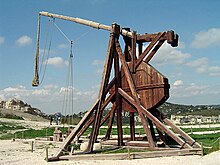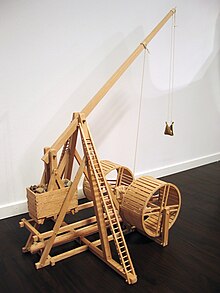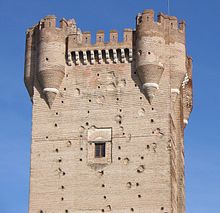Blide

The Blide was the largest and most precise throwing weapon among the medieval siege devices and a sub-form of the catapult . Other names are Tribock or Tribok (plural tribocks ) and Trebuchet (French trébuchet , from Latin trabatium ).
functionality

A sling (blide) works, among other things, according to the lever arm principle , in which a counterweight on the short arm side accelerates the weight on the long arm side. In addition, at the end of the long side of the arm there is a loop in which the bullet is located. The rotation of the noose around the end of the limb ensures a high acceleration of the projectile, which is the basis of the enormous range of the Blide. The ratio of the short to the long arm side is around 1: 4 to 1: 6.

A basic distinction is made between a rigid and a movable counterweight. A rigid weight is firmly connected to the short arm end and thus rotates around the axis of rotation when it is dropped. A movable counterweight hangs (in a box or similar) on the short end of the arm. The counterweight only partially follows the circular movement of the short arm end due to the inertia. Relative to the short end of the arm, the movable counterweight initially swivels inwards and then outwards. According to scientific reconstruction attempts, the mass of the counterweights of military vehicles is estimated to be up to 12 tons; Limbs 18 to 20 m in length led to long ranges.
The now numerous reconstructions illustrate the high level of effectiveness. However, there are almost no historical plans or originals. However, in various places in the vicinity of castles (e.g. Eltz Castle ), Blidenkugeln that originate from sieges have been found, at Burghausen Castle there is still a complete set of supplies. The range of around 300 meters can be proven by historical sources and the situation at the occupied Bliden deployment sites. The necessary size and weight of the corresponding blide can be calculated from the weight of the balls - usually around 30 kilograms - and the range. With the help of these calculations and based on historical images, the various reconstructions were then made. The Blide at Warwick Castle with a total weight of 22 tons and a height of 18 meters throws stones weighing 15 kg 300 meters. The weights of the Blidensteine found are between 10 and 120 kg, rarely less than 15 or over 150 kg. The largest Blidenstein thrown in Germany was thrown at Tannenberg Castle in 1399 , it weighed an estimated 286 kg and was found in the castle's kennel. Most of the time the stones have a flattening at one point, it prevented the stone from rolling away when the slingshot was pulled and served to fix the stone in the sling bag. Smoothly rounded stones, on the other hand, were often ammunition for stone rifles .
Military operation
The machine was made almost entirely of wood and was dismantled and transportable on carts. A team of around a dozen woodcutters and carpenters could also build a new building from trunks on site in two to three days. Some of the blades were fitted with wheels to make adjustment and aiming easier. The idea of mobile bliden that were maneuvered from place to place on wheels is wrong.
A level and solid surface was necessary for the use of a Blide. The throwing distance was adjusted by changing the length of the loop or the counterweight. The long limb made it possible to throw stones up to 450 meters. At the time, this represented the greatest range of all throwing and firearms ( longbows reached a targeted 200 m).
The trajectory of the bullet of a blide could be preselected by setting the throwing angle differently. A high bow throw was chosen for maximum range, and a flatter trajectory for the greatest possible damage to walls. So it was possible to aim at battlements, battlements and roofs of a besieged castle or at the castle walls. Historical reports that within a few days the defensibility of a fortress was decisively impaired by the simultaneous use of several such weapons are credible. Tensioning and loading a Blide with a 15 ton counterweight takes four people in the practical reconstruction half an hour.
Instead of stone balls, other objects such as B. corpses or plague corpses hurled into the enemy fortresses in order to intimidate the enemy, to contaminate the food supplies of besieged cities or to infect the besieged with diseases.
In the Mediterranean area, this weapon (installed lengthways) was also available on ships, with the counterweight swinging down almost to the keel through an opening in the deck.
In historical drawings such as in “ Bellifortis ” by Konrad Kyeser von Eichstadt 1405 or Kolderer 1507, other elements besides the frame, limb and counterweight can be traced. Ladders on both sides are used, among other things, to prepare the noose after the throw. Either large handwheels or pedal wheels are shown for tensioning . In medieval cranes, large loads were moved with pedal cranes, and the considerable force required to tension a large blide can easily be generated with a double wheel. A channel in which the stone is guided for the first few meters enables the precision of the blide. Moving the channel to the side also allows the location of the impact to be changed within limits without having to move the entire blade. In almost all historical drawings, the support frame is inclined and lies directly on the limb at the height of the axis. Because a moving counterweight is braked over a short distance at the reversal point, the axis cannot be cantilevered because at this moment a multiple of the mass acts on the axis. Towards the bottom, the frames become wider so that the counterweight, which needs space to swing, can also be sufficiently large and therefore heavy.
history
In Central Europe the blide appeared from around 1200. It is likely a Byzantine development that was adopted by the Crusaders and Arabs. Bliden was also used in the sieges of Lisbon (1147) and Naples (1191). The predecessor was the Zugblide, which has been documented in Central Europe since the 10th century, in which up to 50 men jerked the short lever arm down with ropes. Due to the lower pulling force of people compared to a counterweight, probably up to 15 tons, on the Blide, the Zugblide could only shoot projectiles with a significantly lower weight. It was also less precise as the pulling power of the team varied from throw to throw.
Building and operating a Blide required a great deal of specialist knowledge. The "Blidenmeister" was a well trained specialist.
In Wolfram von Eschenbach's Willehalm (around 1200) a "drîbock" (111.9) is mentioned in connection with other siege machines - this is the earliest evidence of this machine. According to the " Marbach Annals ", it was first introduced by Emperor Otto IV . used in the siege of the city of Weißensee (Thuringia) and the local Runneburg in 1212. In Wysburg in Thuringia, which was destroyed by Rudolf von Habsburg in 1289/90 , 37 blidenkugel were found.
Military leaders were also killed during sieges by Blidensteine, for example Simon de Montfort in 1218 , Conrad II von Schlüsselberg in 1347 or Albrecht von Sachsen-Wittenberg in 1385 .
The largest reconstructed Blide is in the open-air museum Middelaldercentret Nykøbing in Nykøbing Falster in the south of Denmark .
See also
literature
- Paul E. Chevedden: The Trebuchet - the most powerful weapon of the Middle Ages. In: Spectrum of Science . No. 9, 1995, pp. 80-86.
- Paul E. Chevedden: The Invention of the Counterweight Trebuchet. A Study in Cultural Diffusion. In: Dumbarton Oaks Papers. Vol. 54, 2000, ISSN 0070-7546 , pp. 71-116.
- Mark Feuerle: Blide - Mange - Trebuchet. Technology, development and effect of the projectile gun in the Middle Ages. A study on the medieval history of innovation (= publications of the 1st Center for Experimental Middle Ages, Vechta. Vol. 1). Publishing house for the history of natural sciences and technology, Diepholz et al. 2005, ISBN 3-928186-78-7 .
- Mark Feuerle: The lever gun. A technical innovation of the Middle Ages. In: History of Technology. Vol. 69, 2002, ISSN 0040-117X , pp. 1-40.
- Werner Hahlweg : Blide. In: Real Lexicon on German Art History . Vol. 2, 1942, Col. 907-909 (as of October 22, 2016).
- Peter V. Hansen: Experimental reconstruction of a medieval trebuchet. In: Acta archaeologica. Vol. 63, 1992, ISSN 0065-101X , pp. 189-208.
- Michael Kirchschlager: The Blidenstein - from the "projectile" to the decorative element , in: Burgen und Schlösser , magazine for castle research and monument preservation , ed. from the European Castle Institute , 2017, issue 2, pages 107–120.
- Michael Kirchschlager: Teuflisches Werkzeug Verlag Kirchschlager, Arnstadt, 2018, ISBN 978-3-934277-76-2
- Bernhard Rathgen: The gun in the Middle Ages. Source-critical investigations. VDI-Verlag, Berlin 1928, p. 578ff .: On the Trebuchet and other long-range weapons before the invention of gunpowder. (Reprint. VDI-Verlag, Düsseldorf 1987, ISBN 3-18-400721-9 ; not necessarily up-to-date in the conclusions, but a unique collection of sources).
- Uwe Strack: The Blide - A replica of the most powerful weapon of the Middle Ages. In: Archeology in Lower Saxony . Pp. 135-137, 2006.
Web links
- Video of a throwing process ( Memento from September 28, 2007 in the Internet Archive ) ( MPG ; 1.1 MB)
- Overview of the designs of siege engines
- Report with photos of the replica of a Blide
- Danish Medieval Center; large reconstructions (English)
- Technical and historical information (English)
- Shot example of a replica ; Smithsonian Channel on Youtube
Individual evidence
- ↑ Eugène Viollet-le-Duc : Engin (siege engines). In: Dictionnaire raisonné de l'architecture française du XIe au XVIe siècle. 1868, pp. 210-269. Detailed technical description with illustrations (French).
- ↑ Replica of a trebuchet. Erlebtes-Mittelalter.de ( Memento from February 11, 2013 in the web archive archive.today ).
- ↑ a b Blide (counterweight slingshot). Heureka-Historienkontorei Leipzig ( Memento from May 3, 2009 in the Internet Archive ).
- ^ Beckdorfer Blide. Cityreview.de ( memento from June 29, 2014 in the web archive archive.today ).
- ↑ Middelalder Center: Counterweight Trebuchets. The Gray Company Trebuchet Page, 2002.





